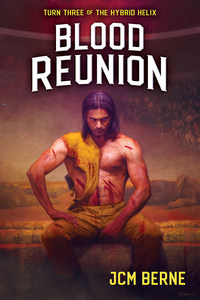Be sure to come back in a couple of hours for a Q&A with Kate Ashwin.
by Kate Ashwin
DETAILS:
Series: No Loose Ends, #1
Publisher: Kate Ashin
Publication Date: November 11, 2024
Format: eBook
Length: 314 pg.
Read Date: January 25-29, 2025


You, like me, may assume that all Cyberpunk novels are set in joyless dystopias, where the neon lights and other brightly colored signs shine out against a gray and raining night (like every scene with Rick Deckard walking on his way to get some food). You’re largely correct. But what if I told you that didn’t have to be the case? Well, read on…
It was around 10 p.m. on a Thursday when Renji thought he might have a go at breaking out of prison. This idea was terrible for several reasons.
One, the prison in question was an Imperium International Forces Containment Facility, the kind widely reputed for being near-impossible to escape. Two, said facility was an airship in flight some fifty storeys above solid ground. The third, and perhaps most important reason was that he wasn’t even a prisoner, he was a guard.
But to I.I. Forces Cadet Renjiro Starkweather, the young man leaning out of the mess hall kitchen’s window to sneak a crafty cig, these reasons didn’t seem quite good enough to not at least have a try.
What’s Hit The Ground Running About?
Renji really doesn’t belong in the Forces—he doesn’t have the mindset, the discipline, any interest at all in serving, But he does have an Aunt who did most of the work in raising him. She’s rich, she’s powerful, she’s overly-indulgent of Renji, but she also has expectations. Hence, his presence in the Forces (which he probably would’ve washed out of already, if not for her influence).
But Renji’s at his breaking point, and he probably would’ve made an attempt at escape if not for the fact that he quite inadvertently interrupted an attempted jailbreak. The downside to this is that he ends up in custody with the jailbreakers—who turn out to be affiliated with a group Renji has been cheering on. They’ve recently released a lot of really embarrassing information about the Imperium International Corporation and other leaders of the city of Unity, in a WikiLeaks-type move. It didn’t do the damage anyone was really hoping for, but it did make a splash and get some people talking.
Okay, I’m taking too long here—Renji and the others (with some help from a super-competent hacker/”gal in the chair”) do eventually escape from the Facility in quite the flashy way, but without everyone they hoped to bring along with them. And Renji ends up visiting a part of the city of Unity he’s not that familiar with, Buried—it’s the part where the workers that support the corporation and government live (as well as their families, the unemployed, and whatnot). If you think of the city of Unity as The Titanic, this would be the third-class passenger area, but not as nice.
Renji wants to throw his lot in with the group, the Loose Ends. He wants to fight back against I.I., not out of any real outrage against them. But he thinks it’d be a fun adventure, and he does want to see things get better for the citizens down below—and to take I.I. down a peg or two. They’re leery of taking him on (mostly because they can tell his motives are shaky and he’ll probably get going when going gets tough—and not in the good way). But when a crisis hits, Renji comes up with a plan that just might work.
It’s nutty, it’s risky (mostly for him), but if he can pull it off with a little assistance from the Loose Ends and an older, battle-tested temporary ally of the Loose Ends, a lot of good can be done and the crisis could be averted.
The Characters and World
So the villain of this book is really “the System” as represented by Imperium International Corporation (and as you get to know them, you’ll be able to imagine any number of mega-corps of today turning into them).
But we get a few representatives of The System to focus on—nothing more than low-level hench-persons really. But higher-level reps will have to wait for the sequels. Primarily, we’re looking at Renji’s sergeant and three fellow-cadets who absolutely are not Malfoy, Crabbe, and Goyle. But they do fit the same character types that those three do. All four of these antagonists are the kind you will enjoy seeing foiled—even if they are the bottom of the rung, you’ll have a lot of fun seeing Renji go up against them. Especially when he comes out on top.
The heroes—sort of a rag-tag rebel group (who really aren’t trying to overthrow anyone, just trying to survive). They’re a hodge-podge of ages, temperaments, and skills. You will almost instantly like them—while wanting to ask so many questions about all of them. I’m tempted to talk about all of them for a sentence or two, but that would get old. But I like their internal dynamics, I like them as individual characters and cannot wait to see Ashwin develop them all. They also have a number of allies—from people who work in food stalls, to a club owner, to a strange medic/tech repair duo. Really, the Loose ends and the allies we meet in this book deserve a short story or two each, just to give them a chance to shine. (Ashwin, if you see this post and run with it—no need to cut me in, the results will be reward enough. Unless this lands you a TV deal or something.).
Then there are the largely nameless and faceless people in Buried. They suffer due to what I.i. does. They have to deal with any retaliation that comes down due to Loose Ends. We don’t see much of them, but we get to meet their Community Council (even in a dystopia, lower-level government officials are petty and useless, good to know some things are constants). There’s enough citizens, and enough grudges, seen that Loose Ends will have a steady supply of potential allies in future books (and probably future turn-coats, but let’s focus on the positives).
Unity City, once-upon-a-not-too-distant time, was the city of Steelpool, which the corporation bought from a struggling U.K. government to act as its wold headquarters. It’s from Unity that I.I. can distribute it’s Internet programming, sell and market its products, and so on. Mid-level Executives on up, live there. The workers, support staff, their families, etc. are stuck in Buried.
Is This Actually Cyberpunk?
“Please, look at him. He’s even worse of a blagger than you. He looks like he’s gonna sell you life-coaching advice through the internet.”
“Does not.”
“Does too. He’s a budget vampire. That’s a bargain bin Dracula, that is.”
“You are not being a very supportive friend right now.”
“I’m not supportive. Or your friend. Besides, actual supportive friends would tell you when you’re dating an evil executive from a shitty Robocop sequel. He looks like he’s going to have his plans to bulldoze the zoo foiled by some plucky teenagers.”
It’s being marketed as cyberpunk. But I think a lot of readers are going to bump up against the tone—the humor, the snark, the optimism that Renji brings and wonder about that.
If you look at the tech (which I haven’t done a good job of describing), the merger of corporation/government/city-state military, the dystopian nightmare that most of these people endure. You’ve got yourselves the making of a decent cyberpunk reality. But what about tone?
But you’ll be grinning throughout this book, there’s some good laughs, there are some goofy moments, and so on. How does that fit with William Gibson and Bruce Sterling’s Mirrorshade vision? Can you do a non-noir cyberpunk? I think yes. Think of Snow Crash while Hiro is a pizza delivery driver (sure, that’s post-cyberpunk), some of Rudy Rucker’s work, and …a couple of others I suddenly can’t think of the names of. There are even bits of Gibson’s Sprawl trilogy that are about this amount of fun. So yeah, it’s an outlier, but it’s not without precedent.
I only bring this up because I’m pretty sure there are some purists who’d complain about this. People who ignore the whole “punk” part of the aesthetic, no rules, etc. I really don’t care what others think. I’ll take a cyberpunk that makes me grin any day (especially now).
So, what did I think about Hit The Ground Running?
“Stopping them.” The tired look in Minjun’s dark eyes seemed as though it came from a much older man. “This isn’t afable with some terrible dragon for the heroes to hunt down, or a magic combination of words that will break the overlords’ evil spell. This is a city, a society, an ecosystem with problems embedded in its very roots. How exactly do you stop a society?”
This is a heist novel and I wait until now to talk about a heist? What is wrong with me? It’s an audacious plan with a great and benevolent pay-off. Naturally, as any self-respecting heist story demands—it goes awry. The reader knows that even before Renji outlines his plan—the questions are: how does it go awry, and how do our heroes respond? All I’m going to say about that is that I’m eager for book 2 in this series.
This is a fast-moving story with a lot of moving pieces—Ashwin keeps the plates spinning just fine and moves the story along just fine. This is so hard to talk about without getting into the details of the heist, the character twists (of the two bigger ones, I saw one coming miles away and the other took me totally unawares) were revealed with panache, or anything else.
Ashwin’s been storytelling for a long time in graphic novels, she knows how to tell a story and bring characters to life. Turns out she can do that just as well with words as she can do with pictures and words (or so I assume, I haven’t dipped a to in to that yet).
There’s a bit of a budding romance (or is it just a lust story?) that acts as a great distraction for Renji, too. That didn’t do much for me, I thought we had enough other things to keep the story going—but it’s a good plot complication—and who knows, maybe it lays the groundwork for something better.
This is a quick read. A fun read. There are so many bits and pieces I’d call out here, but you should read them for yourselves.
If you’re up for a good time (even if cyberpunk isn’t your thing—just think of it as snarky SF), you’d do yourself a favor to give this a whirl. I need to see what comes next, and I expect after your introduction to the Loose Ends, you will, too.
This post contains an affiliate link. If you purchase from it, I will get a small commission at no additional cost to you. As always, the opinions expressed are my own.

 Happy Jack and the Scary-Ass Book of Doom
Happy Jack and the Scary-Ass Book of Doom
![]()














 The World Savers
The World Savers 


